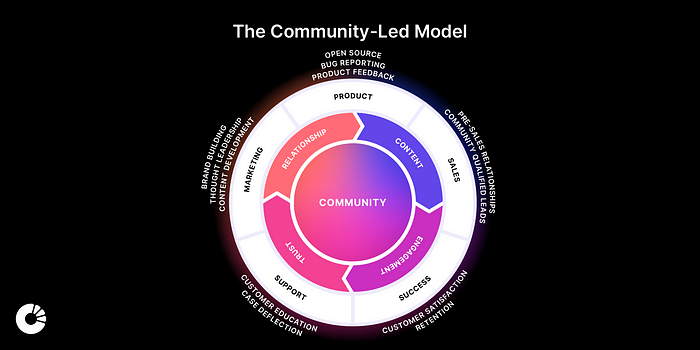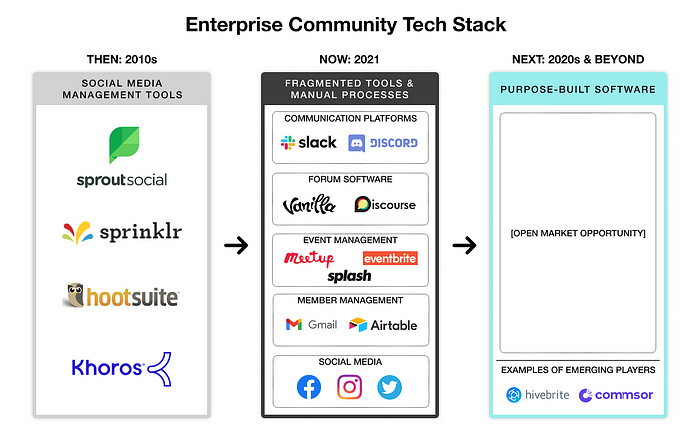The Rise of the Community Department
When I joined Peloton back in 2016, the concept of community management within companies was still somewhat nascent, and we were one of the few startups at the time to have a dedicated community leader. But even then, it was clear that Peloton’s community was special. The company’s now 400K member Facebook group always buzzed with activity, and every year thousands of members from all across the country would flock to NYC for Peloton Homecoming. Peloton’s founders very much believed in the power of their community and cared deeply about what their members wanted, instilling a member-first culture from the very beginning.
While Peloton had no problem growing its community with best-in-class engagement and advocacy, it did experience pain points in managing its community. This came down to a lack of community-specific tools and limitations of existing platforms like Facebook. It was time-consuming and manual to draw important insights, and challenging to manage workflows across many different platforms.
Want to read this story later? Save it in Journal.
Fast forward to today and the challenges we faced at Peloton 5 years ago still very much exist. In most businesses, community data is incredibly rich but siloed and disconnected from the rest of organization’s systems (CRM, customer support, etc.). Although community has taken on a new meaning in most companies, community tools (or lack thereof) have not evolved to keep pace.
Community tailwinds in the enterprise
In recent years, community has evolved from a “nice to have” to a key business priority in modern companies. Companies across different industries and sizes are waking up to the fact that community can be a driving force for some of their most important metrics and goals like acquisition, engagement, and retention — and that community can in fact create long-term competitive advantage. Many smart people have written about community being a fundamental business strategy — see Community Takes All by D’Arcy Coolican or The Community-Led Growth Model by Mac Reddin, to name a couple.

In many ways, products (software or otherwise) are no longer sold by salespeople or by ads, but by community members. As communication proliferates online, a company’s potential customers are being saturated with information — not to mention overwhelmed with options as the number of software products continues to explode. In this environment, users turn to each other as a trusted source for recommendations; the community-led sale is the one that wins. Combine that with community’s impact on retention and engagement and it’s not hard to see how community-driven products will win against their non-community counterparts in the long run.
“Community is the ultimate pressure test of what your brand stands for.”
— Kim Johnson, former Community Lead at Glossier
Against that backdrop, companies are building new playbooks for growth, monetization, and more around community. Businesses are investing in community, in community initiatives — and importantly, in community teams. Hiring dedicated community professionals is becoming the norm, rather than the exception. Modern enterprises ranging from Consumer (Rent the Runway, Hinge, etc.) to Fintech (Chime, Digits, etc.) to SaaS (Coda, Miro, Invision, etc.) to developer tools (Okta, MongoDB, etc.) and everything in between have hired, or are actively hiring, community leaders. But we are still in the early innings of seeing these teams get built out.
The role of the community team and the emergence of a new department
As with all emerging functions, the role of the community team is very much still evolving and tends to vary widely across different organizations. At a high level, community teams are tasked with building communities (both internal and external, online and in-person), managing community programs (including but not limited to content distribution, events, digital engagement, community support, etc.), and creating the community vision for the company. Community roles are by definition highly cross-functional; community managers are critical business partners to many teams, including Product, Marketing, and Customer Support. They act as the liaison between the company’s community and its brand, voicing important feedback from community members and ensuring that the community stays engaged across both online and offline channels.
Although community roles are becoming more common across a variety of companies, community teams still tend to be relatively small compared to other functional areas. Companies may start by hiring a single community professional (usually Community Manager) — this is the stage many companies are at today. These community professionals or teams typically sit within a larger function (most commonly Marketing or Customer Experience) and may have dual roles at the outset (e.g., Community and Social).
However, as community continues to take on more and more importance to the company’s overall strategy, community teams will necessarily need to grow in size and maturity to keep pace. These teams will take on their own set of mandates, goals, and metrics that are distinct from (but of equal importance to) those of other functions. Within those teams, individual roles will need to specialize to meet the increasing complexity of the company’s community.
We will see Community become a department in its own right as this trend continues. Here is an example of what tomorrow’s Community department might look like.

With large teams and important business goals to lead, Heads of Community will earn a rightful place on the executive leadership team. Community leaders will no longer be embedded inside other functions — they will be valuable enough to stand alone and to build large, high functioning teams.
Software needs and gaps
Unlike their counterparts in other departments who have almost too many software options to choose from these days, community professionals have had to make do by working across existing platforms and stitching together manual processes.
Until recent years, community managers have largely operated within social media management tools like Hootsuite and Sprout Social. These tools enable community managers to handle social interactions at scale, particularly around publishing content and replying to community members.
As the role of community management has expanded beyond social, community managers have had to expand the platforms they use as well. Today, community managers’ tools are extremely fragmented.

I have shown a snapshot of these fragmented tools and manual processes above, which include platforms for communication, forums, events, social media, and member management. This fragmentation requires community managers to constantly context switch and make decisions without a single consolidated view of their world.
In the last decade, we saw the emergence of Customer Success as a department and the corresponding creation of a new category of horizontal software (Gainsight, Catalyst, ChurnZero, etc.). I predict a very similar trend will happen with Community and Community software in the next decade.
Community as the next big horizontal SaaS category
As an emerging department, Community has its own set of needs distinct from those of other departments, and will require purpose-built software to support those needs.
As Community becomes core to the business, community data will likewise be mission critical. Community teams need technology to help them manage that data, deliver analytics, and maintain a single source of truth.
I need the community version of a CRM — a place where I can see all of the different touchpoints for every member of my community.
— Jayvee Nava, VP of Community at Peloton
Ultimately, communities will look very different across different companies, so different community managers may have different needs. However, there is a core set of functionality that every user should look for in community-specific software platforms.
Here is what I think winning Community SaaS will look like:
- System of record for community data and daily operating platform for the community team
- Community “CRM” — should integrate across the entire community tech stack to provide a single (“360 degree”) view of every community member, including granular activity history from third party platforms, internal systems, etc.
- Member segmentation — should consolidate community member data and make it easy to segment members along various dimension (e.g., engagement type, influence, etc.)
- Growth — should provide tools to measure and increase community growth, including self-service tools for different community entry points, as well as analytics on community “funnels” (i.e., where are new members coming from?)
- Engagement — should surface insights on engagement levels of the community across different platforms and provide answers to detailed questions like “who are my most engaged community members?”
- Workflow automation to help scale actions across day-to-day initiative and activities (e.g., events, communications, member management, incentives, etc.)
With this wishlist in mind…the opportunity to serve community teams (and the future Community department) with software is wide open. Emerging players in this space should partner with community leaders today to begin building out best-in-class platforms that will be able to scale as these teams scale. I for one am very excited to see new companies build into this open market opportunity, as a new software category is created for the modern enterprise.
If you’re building community tools or software, I’d love to chat. You can reach me by email (lisa@firstmarkcap.com) or on Twitter (@lisamxu).
Many thanks to Jayvee Nava (VP of Community, Peloton), Kim Johnson (Head of Community, Geneva; former Community Lead, Glossier), Becky Leader (VP of Community, Rent the Runway), and Anita Parikh (Community Programming and Partnerships, Chief) for their contributions to this post and to Jenna Clemens for her design help.
